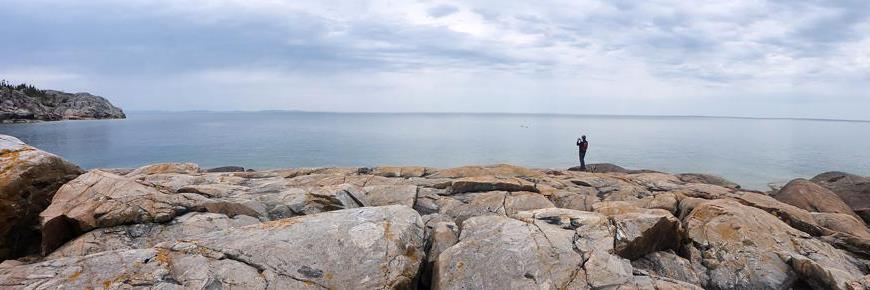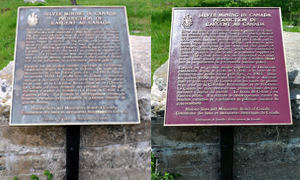
Making history
Pukaskwa National Park
By Nicole Cooper and Svenja Hansen
More than three dozen people, places and events have been identified as being of national significance across Northern Ontario. Over the course of 10 days and more than 3000 km, we visited 22 of these designations—getting a serious appreciation for the vastness, beauty and history of Northern Ontario.
Parks Canada is responsible for marking each of the above designations with a bilingual burgundy and bronze plaque from the Historic Sites and Monuments Board. Once these plaques are in place, it also falls to Parks Canada to make sure they are maintained. So, our epic road trip wasn’t a joyful holiday… we were planning on fixing up five of the plaques that had become faded or tarnished in recent years.
 Nicole sanding the letters to remove tarnish
Nicole sanding the letters to remove tarnish© Parks Canada
Moreover, Nicole is working on creating a new geocaching program—a sort of history scavenger hunt using Global Positioning System (GPS) devices, like smartphones and handheld or vehicle mounted GPS gadgets—which will guide tourists and local folks to these national historic plaques.
During the trip we documented the condition of all plaques and stands, taking pictures and recording their GPS locations. We met lots of lovely people, like Patrick Julig an archaeologist and professor at Laurentian University, who shared his passion for Sheguiandah National Historic Site on Manitoulin Island with us on a hike. Many of these individuals manage the land upon which these markers are installed, others were just out for a visit and came up to us to ask us what we were doing. It’s a wonder we didn’t scare them away, when you look at the HAZMAT outfits we wore while painting.
 BEFORE – Silver Mining plaque tarnished and weathered. AFTER – Silver Mining plaque painted and polished.
BEFORE – Silver Mining plaque tarnished and weathered. AFTER – Silver Mining plaque painted and polished. © Parks Canada
In the end, we only managed to refinish three of the five plaques, because we were surprised by four days of much needed rain, which put a damper on the forest fires in the Timmins and Kirkland Lake areas at the time.
It was a long trip, but well worth the effort. So, if you see a beautiful shiny national historic plaque in Sudbury at the Big Nickel, or in Cobalt for Silver Mining, or in Moose Factory recognizing Philip Turnor, you are looking at our handy-work.
- Date modified :